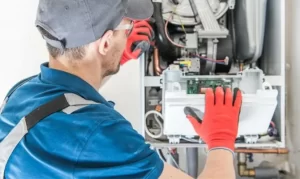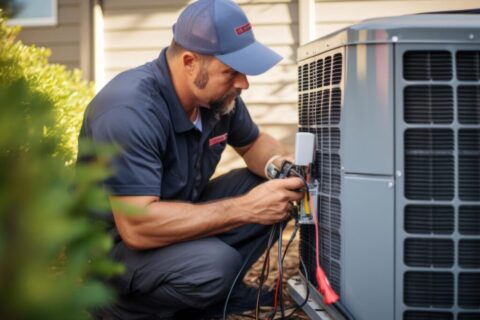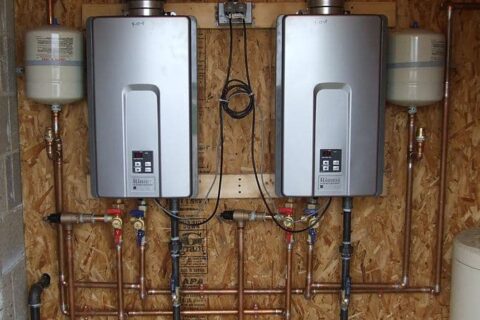Furnace Error Codes: A Homeowner’s Troubleshooting Guide
Key Takeaways
-
Furnace error codes are essential for identifying specific issues in your heating system, helping you troubleshoot problems quickly and efficiently.
-
Learn how to read these error codes to avoid causing additional damage, save on repair costs, and identify small repairs from major issues.
-
Many furnaces indicate error codes with blinking lights, and counting the blinks can quickly tell you what’s wrong. Always refer to your user manual for the correct interpretation.
-
Majority of common error codes, such as ignition failure and pressure switch error, signify repairable issues. Dirty filters, blocked vents, or faulty components are almost always the cause of these problems.
-
To troubleshoot, begin by determining the error code and referring to the user manual. Then, check the furnace components, reset the unit, and remember—you can always reach out to an expert for help.
-
Regular maintenance is critical to the performance of your furnace. By regularly replacing filters, cleaning your vents, and scheduling annual inspections, you can avoid problems and enjoy long-term efficiency.
Troubleshooting common furnace error codes may seem like a daunting task, but knowing these common codes is an invaluable homeowner’s skill. Today’s furnaces have built-in diagnostic systems that provide error codes for you to troubleshoot when something isn’t operating correctly.
These codes are helpful indicators of the problem at hand, such as a loss of airflow, ignition failure, or sensor errors. Understand how to read the warning signs of small issues. That way, you’ll know right away whether you can handle the repairs yourself or if it’s time to call in a pro.
This guide simplifies the most common error codes, so you can save time and skip the stress of a troubleshooting fire drill. Whether it’s a blinking LED or a numeric code, knowing what it means ensures your furnace stays reliable during colder months.
What Are Furnace Error Codes
Furnace error codes are the system’s way of speaking to you about the issues at hand. These codes are communicated via a series of flashing LED lights on the furnace. One brief flash indicates the first number of the code, while a long flash indicates the second digit. Understanding Goodman furnace error codes is essential for diagnosing the problem, whether it’s an issue with the gas valve, a bad flame sensor, or a pressure switch error.
These furnace error codes serve as your furnace’s translator, relaying information from your furnace to you or an HVAC repair person. Rather than leave you guessing about what the issue is, the furnace tells you what’s going on in no uncertain terms. This saves you time as well as repair costs from escalating.
If the error code calls for a basic reset, you might be able to take care of it yourself. Simply follow the troubleshooting steps outlined in the manual for your furnace model—such as flipping the configuration switch “SW-1” to “on” and jumpering thermostat terminals “R,” “W/W1,” and “Y/Y2.”
Although codes differ from brand to brand, the process of reading them is usually the same. For instance, a Lennox furnace will indicate a problem by varying the speed of its blinking indicator light. It utilizes the LED light’s color to indicate specific malfunctions, making it easier for furnace specialists to diagnose issues.
Nearly every major brand provides a user manual that has a handy chart that can tell you what each code means. Even newer units such as the 060 and 20 can handle continuous fan operation of up to 2,000 CFM. They don’t just do this on paper.
Given that 9 out of 10 furnace problems are detectable via an error code, it’s important to know what they mean. By utilizing a Goodman furnace error code guide, you can quickly identify and address many furnace problems before they escalate into serious issues.
Common Furnace Error Codes and Meanings
Furnace error codes
Built-in error codes act as your furnace’s communication system, alerting you to underlying causes before they lead to bigger problems. Most models, including Bryant furnaces, utilize blinking LED lights to relay critical details and error codes. These codes provide valuable hints about what’s going on with your furnace.
By familiarizing yourself with these codes, you are better empowered to troubleshoot issues quickly, saving time and money, particularly in the middle of a brutal winter. Below, we demystify some common furnace error codes and their meanings.

Ignition Failure Code
An ignition failure code often indicates a problem with the furnace’s ignition system. This may be due to a malfunctioning igniter or a gas supply outage. If your furnace won’t ignite, start by checking the power to your unit to be sure it is receiving the proper voltage.
Then, make sure that the gas valve is open. Fixing this code may not sound like a big deal, but doing so can save extended heating outages. Routine maintenance, such as checking the igniter as part of an annual tune-up, can help prevent this error from occurring.
Pressure Switch Error Code
This code indicates an airflow issue, usually due to a clogged vent or failed pressure switch. For instance, leaves or other debris covering vent pipes can cause this error. Check the venting system for any blockages and ensure the pressure switch is working properly.
Proper airflow not only fixes this error but increases heating efficiency.
Flame Sensor Error Code
A flame sensor error indicates that the furnace may not be detecting the flame, usually because the sensor is dirty or defective. Cleaning the flame sensor will usually fix this error. Shrugging it off, though, can result in ignition lockout, which prevents the furnace from turning on at all.
Fortunately, replacing a bad flame sensor is typically a quick and inexpensive fix.
Limit Switch Error Code
This code is triggered by overheating or restricted airflow, usually due to filthy filters or clogged ducts. Regular filter inspections and replacements will keep them from overheating and ensure their continued optimal performance.
Poor airflow is the cause of this error and it can stress the system and result in expensive repairs.
Blower Motor Error Code
A blower motor error indicates that the furnace’s blower motor is experiencing problems like clogs or electrical issues. For example, if dust or debris accumulates in the motor it can lead to overheating.
Make sure the motor is clean and getting enough power. Because your blower motor is responsible for moving heat throughout your home, it’s important to keep this component in top condition for efficient heating.
How to Troubleshoot Furnace Error Codes
1. Identify the Error Code
First, use the error code showing on your furnace to guide your troubleshooting. Most modern furnaces communicate error codes via blinking light patterns or digital display panels that illuminate to point out the precise problem. Look closely at the number and order of the blinks, as these sequences usually indicate specific issues.
For instance, a code of two short blinks, then one long blink could indicate a problem with your sensor. Make sure to write the error code down for reference, as this will be important in the troubleshooting process. Accurately identifying the code means you know you’re working on the correct problem, saving time and frustration.
2. Refer to the User Manual
Your furnace’s owner’s manual is an incredible tool when trying to interpret error codes. It’s full of helpful guides that give detailed explanations of what each code means and how to fix it, usually with step-by-step instructions. If you’ve lost the manual, most manufacturers provide electronic versions on their website.
Think about making a one-page quick reference guide for the most common codes to make it easier to troubleshoot on future calls. Familiarizing yourself with your manual beforehand makes troubleshooting quick. It’ll raise your comfort level in tackling small problems, too.
3. Inspect Furnace Components
After determining which error code is present, check important parts including the air filters, vents and any sensors. A dirty filter or a blocked vent is a common culprit to trigger error codes. In most cases, you can fix this problem by cleaning or replacing the malfunctioning component.
Check all wiring and components for obvious signs of wear or damage, like frayed wires or rusted sensors. Routine maintenance through inspection and cleaning can prevent small problems from becoming big ones, usually at a lower cost.
4. Reset the Furnace
Once you’ve fixed the problem, you’ll need to reset your furnace to clear the error code. Most furnaces include a reset button, but the procedure may differ depending on the model. Shut the furnace off for several minutes, then power it back on.
This often clears up temporary glitches, getting everything back on track. Even after resetting the furnace, keep a close eye on it and make sure the problem doesn’t reappear.
5. Contact a Professional if Needed
If you troubleshoot and the issue still persists, don’t delay. When in doubt, always call a professional HVAC technician right away, particularly if you start to notice dangerous problems such as gas leaks.
When it comes to complex issues that include gas or electrical components, we recommend seeking expert knowledge. Prevent future breakdowns Routine maintenance checks by professionals can help prevent future breakdowns and ensure your system is running at optimum efficiency.
It’s a minor investment that will spare you major repair costs in the future.
Tips for Preventing Furnace Issues
Follow these tips to prevent furnace issues and you’ll be on your way to ensuring your heating system operates efficiently and without surprise breakdowns. Taking a proactive approach can save you time and money in costly repairs.
It plays an important role in keeping your home energy efficient and comfortable during the colder months. Here are a few steps you can take to prevent furnace issues.
Perform Regular Maintenance
Regular maintenance goes a long way in preventing these issues and ensuring your furnace is running smoothly. Preventive Measures Begin with cleaning or replacing filters every 1-3 months as dirty filters can cause airflow restrictions.
Dust and debris can clog up filters, making the furnace work harder and raising energy bills. Check the area around your furnace and remove any debris or dust that could obstruct airflow (including things like excessive storage or dust buildup).
Scheduling professional tune-ups annually is a major preventive step. During maintenance appointments, HVAC technicians can clean internal components, check for wear and tear, and make sure all systems are functioning properly.
Maintaining your system regularly can help your furnace last longer and run more efficiently.
Replace Filters Frequently
Replacing clogged filters regularly is essential in preserving airflow and efficiency. A dirty filter forces your system to work harder and can even cause your system to break down.
Changing your filters about every 1-3 months will help avoid dust accumulation and ensure your unit continues to run effectively. Filters of the highest quality that are made specifically for your model furnace are the ideal option.
To keep a regular schedule, create calendar reminders or time replacements to certain dates, such as the beginning of each season.
Keep Vents and Ducts Clean
Removing clogs in vents and ducts promotes healthy airflow in your home. Blocked vents can cause your furnace to overheat and trip error codes on your furnace.
Vacuum visible vents regularly, and have ducts professionally cleaned every few years to remove built-up debris. In addition to better furnace performance, clean ducts create better indoor air quality, a vital aspect for homes that have family members with allergies or other respiratory ailments.
Schedule Professional Inspections
Regular, annual, professional inspections can catch issues early on and save you from expensive repairs down the road. From gas leaks to clogged condensate drains to worn-out components, HVAC technicians will catch these potentially dangerous issues before they become a problem.
Most contractors have maintenance contracts available, which can give you extra peace of mind and support throughout the year. These inspections improve the safety, reliability, and performance of your furnace.
When to Call a Professional
Persistent Error Codes
If some specific error codes keep coming up on your furnace, it’s usually a bad sign that something more serious is at play. DIY troubleshooting can be extremely helpful. If the same error messages keep popping up, it’s more likely to be an error-prone component or system failure.
If you see the same code for a flame sensor or pressure switch again after resetting the furnace, it’s likely that component needs replacement. It might need to be changed. Monitoring the pattern and frequency of these error codes can go a long way toward helping a professional technician make an informed diagnosis.
When basic troubleshooting fails, an expert is able to get to the root cause of the problem and make the appropriate fixes.
Unusual Noises or Smells
Strange noises or odors coming from your heater are often the first signs of a much more dangerous problem. If it’s rattling or banging it may just be loose parts, squealing could indicate a problem with the motor.
Similarly, smells such as gas or burning can be a sign of a leak, overheating or another danger. Any time you smell gas, you should consider it an emergency—shut down the furnace and get out of your home right away.
Bizarre signs such as these need professional inspection to protect against the risks of injury and to prevent further damage from occurring. The industry surveys show that 80% of DIY attempts in these situations only cause more damage.
Lack of Heat or Airflow
If your furnace isn’t heating like usual, or the airflow seems weak, begin with easy fixes. Make sure the thermostat is on “heat” mode, and check vents and filters for obstructions.
If the issue continues, it’s worth bringing in a pro. Extended absence of heat can increase discomfort and stress your furnace system, leading to higher repair costs down the line. A timely diagnosis prevents these complications.
Safety Concerns
Whenever in doubt, put safety first. If you observe any signs of hazards such as gas leaks, electrical faults, or unexplained shutdowns, you should call in an expert right away.
Shutting off your furnace and calling in an emergency technician can ensure that you’ll avoid dangerous situations and keep your home safe and warm. Regular professional inspections, such as an annual HVAC tune-up, prevent risks and help everything run in peak condition.
Conclusion
Knowing what to look for with common furnace error codes will save you time and frustration. Recognizing these codes gives you a clear idea of what might be wrong and whether you can handle it yourself or need help. Things like checking your filters or resetting the system are an easy fix and can save you the hassle of a service call. Aside from ensuring your furnace is as efficient as possible, regular maintenance helps avoid many common furnace issues altogether.
If the issue appears to be more complicated or safety is in question, reaching out to a pro is always the smartest decision. You’re not in this battle by yourself. A furnace that’s working properly equals a happy home, especially in the cold winter months. Keep your furnace error codes troubleshooting skills sharp, and don’t let minor problems turn into major emergencies. Your furnace will appreciate it—and so will your wallet.
Frequently Asked Questions
What are furnace error codes?
Furnace error codes are diagnostic fault signals displayed on your furnace, aiding in understanding goodman furnace error codes and identifying issues like ignition failure or airflow obstruction, allowing you to troubleshoot errors and resolve them quickly.
Why is my furnace showing an error code?
Your furnace uses error codes to alert you to a problem it’s detected, which can include common furnace troubleshooting codes like a dirty filter, a blocked vent, or a malfunctioning part. Consult your goodman furnace error code guide to determine what the problem is.
Can I fix furnace error codes myself?
While you may handle basic problems like replacing air filters or resetting the furnace, for serious issues, it’s wise to consult furnace repair experts to ensure accurate diagnosis and prevent further damage.
How do I reset my furnace after fixing an error?
Turn off the furnace at the thermostat and circuit breaker, if applicable. Wait at least 5 minutes, then turn it back on. If the common error code patterns continue, call in a furnace repair expert.
What are the most common furnace error codes?
Common codes include:
-
Ignition failure
-
Blower motor issues
-
Flame sensor problems Check your manual for specific meanings.
How can I prevent furnace errors?
Regular maintenance is crucial for any furnace, including Goodman models. Scheduling annual tune-ups and changing your filters every 1–3 months can significantly increase your furnace’s lifespan and prevent many furnace problems before they occur.
When should I call a professional for furnace errors?
If your furnace error code indicates an electrical, gas, or mechanical failure, immediately call a furnace repair expert. Improper DIY fixes can be hazardous and potentially lead to further damage.


